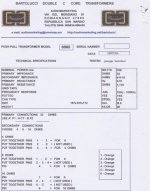Hi Mike,
I wonder if I might enter my thoughts here.
I don't regard Susan's amplifier, or the one I am trying to make, as being 'passive'.
They are active 'followers'. But unlike NFB amplifiers they are not 'reactive'.
Thus no time delayed products due to loudspeaker back EMF generation are *reactively* countered by a second NFB amplifier input coincidentally operating wrt the input waveform. Yes, the loudspeaker current will still be self back EMF modified, and the follower amplifier's output does become passively loudspeaker current modified, but it does not reactively generate new fractional error voltages that would otherwise arise due to multistage phase change and low biasing.
The original four transistor JLH class-A already behaves very competently in both these regards, but these get so hot when greater power output is required.
An output transformer can have weaknesses at audio frequency extremes and when not operating in pure class-A (which excludes toroidals), but it does have advantages.
Identical per-half devices can be used such that the amplitude differences between halves are not going to generate an underlying alternating voltage error on tonebursts.
Susan's and Rozak's prior constructions utilise an output transformer, and it is only when I simulate realistic values for power rail characteristics, with input, output and bias all established wrt a common ground, that I see the psu does not need to be well regulated, merely power/voltage capable.
Non NFB controlled NPN/PNP complementary push-pull halves amplifiy differently, and thus introduce an underlying error.
An all NPN and output transformerless output stage has the upper half working wrt output and the lower half wrt the negative rail. Only on a simulator can this arrangement be made to work, because low frequency bias shifts arise with current draw when the virtual psu is given real world characteristics.
My conclusion - the output transformer is an essential part of a push-pull 'follower' design, and Susan's simple circuit has for long had much to commend it.
My efforts continue.
Cheers ........... Graham.
I wonder if I might enter my thoughts here.
I don't regard Susan's amplifier, or the one I am trying to make, as being 'passive'.
They are active 'followers'. But unlike NFB amplifiers they are not 'reactive'.
Thus no time delayed products due to loudspeaker back EMF generation are *reactively* countered by a second NFB amplifier input coincidentally operating wrt the input waveform. Yes, the loudspeaker current will still be self back EMF modified, and the follower amplifier's output does become passively loudspeaker current modified, but it does not reactively generate new fractional error voltages that would otherwise arise due to multistage phase change and low biasing.
The original four transistor JLH class-A already behaves very competently in both these regards, but these get so hot when greater power output is required.
An output transformer can have weaknesses at audio frequency extremes and when not operating in pure class-A (which excludes toroidals), but it does have advantages.
Identical per-half devices can be used such that the amplitude differences between halves are not going to generate an underlying alternating voltage error on tonebursts.
Susan's and Rozak's prior constructions utilise an output transformer, and it is only when I simulate realistic values for power rail characteristics, with input, output and bias all established wrt a common ground, that I see the psu does not need to be well regulated, merely power/voltage capable.
Non NFB controlled NPN/PNP complementary push-pull halves amplifiy differently, and thus introduce an underlying error.
An all NPN and output transformerless output stage has the upper half working wrt output and the lower half wrt the negative rail. Only on a simulator can this arrangement be made to work, because low frequency bias shifts arise with current draw when the virtual psu is given real world characteristics.
My conclusion - the output transformer is an essential part of a push-pull 'follower' design, and Susan's simple circuit has for long had much to commend it.
My efforts continue.
Cheers ........... Graham.


